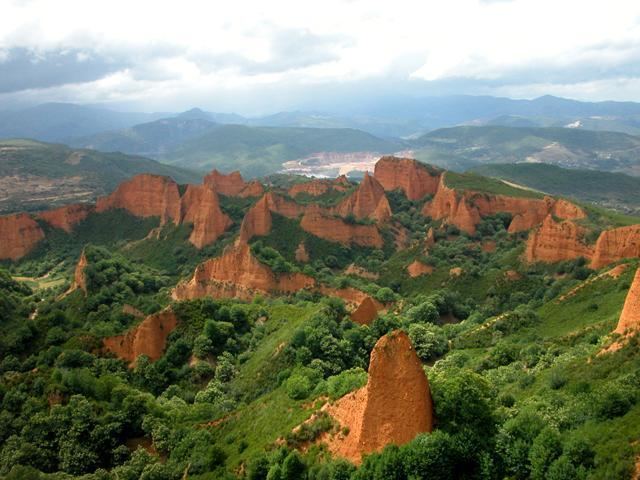Country Spain Area rank Ranked 7th Area 15,581 km² | Parliament Cortes Generales Population 484,694 (2014) | |
 | ||
Demonym(s) English: LeoneseSpanish: Leonés/Leonesa Official language(s) Spanish, Leonese and Galician special protection status Colleges and Universities University of León, Universidad de León, Vegazana, Universidad de León, Ponferrada Points of interest Basílica de San Isidoro - L, León Cathedral, Casa de los Botines, Convento de San Marcos, Palacio de los Guzmanes Destinations León, Picos de Europa National, Astorga - Spain, Ponferrada, Sahagún | ||
León (/leɪˈɒn, -ˈoʊn/; Spanish: León [leˈon]; Galician: León [le'oŋ] ; Leonese: Llión [ʎiˈoŋ]) is a province of northwestern Spain, in the northwestern part of the autonomous community of Castile and León.
Contents
Map of Le%C3%B3n, Spain
About one quarter of its population of 500,200 (2008) lives in the capital, León. The weather is cold and dry during the winter.
There are Roman Catholic cathedrals at León and Astorga. The province shares the Picos de Europa National Park (in the Picos de Europa mountain range) with Cantabria and Asturias. It has 211 municipalities.
History
The province of León was established in 1833 with the new Spanish administrative organisation of regions and provinces to replace former kingdoms. The Leonese Region was composed of the provinces of León, Salamanca and Zamora.
Until 1833, the independently administered Kingdom of León, situated in the northwest region of the Iberian Peninsula, retained the status of a kingdom, although dynastic union had brought it into the Crown of Castile. The Kingdom of León was founded in 910 A.D. when the Christian princes of Asturias along the northern coast of the peninsula shifted their main seat from Oviedo to the city of León. The Atlantic provinces became the Kingdom of Portugal in 1139.
The eastern, inland part of the kingdom was joined dynastically to the Kingdom of Castile first in 1037–1065, again 1077–1109 and 1126–1157, 1230–1296 and from 1301 onward. (See Castile and León#Historic union of the Kingdoms of Castile and León.) León retained the status of a kingdom until 1833, being composed by Adelantamientos Mayores, where Leonese Adelantamiento consisted of the territories between the Picos de Europa and the Duero River.
In 1188 the Kingdom of León developed what may have been the first Parliament in Europe after the Parliament of Iceland. In 1202 its parliament approved economic legislation to regulate trade and guilds.
Language
The Leonese language is recognized by the Statute of Castile and León. The Provincial Government of León signed accords with language associations for promoting Leonese. Leonese is taught in León city, Mansilla de las Mulas, La Bañeza, Valencia de Don Juan or Ponferrada for adult people, and in sixteen schools of León city. The City Council of León writes some of its announcements in Leonese in order to promote the language.
In the western part of the El Bierzo, the westernmost region of the province, Galician language is spoken and taught at schools. It is also officially recognized by the Statute of Castile and León.
Cuisine
Embutidos
Cheese
Wines
Sweets
